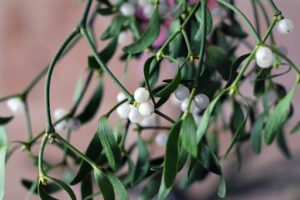
Date March 17, 2023
Category
While mistletoe may be a festive decoration, it’s not necessarily something you want growing on your trees. While more than 1,300 species of mistletoe exist, each one is considered a parasite. In fact, many people decide to remove mistletoe for the sake of the other flora in their yards.
Mistletoe Can Cause Early Tree Death
Image via Unsplash by clementbb
All mistletoe species are parasites, which feed on the nutrients and water of a tree. While many trees are affected by mistletoe, elm and hackberry trees are often the victims of this nuisance. If a tree becomes infested with mistletoe, the growth may cause it to die early. While dead trees provide homes for many animals, most homeowners aren’t thrilled with this prospect. For this reason, removing mistletoe is often a priority.
Some species of trees are resistant to mistletoe. These plants include the crape myrtle, pecan , golden raintree, sycamore, and live oak trees. Keeping these trees around can help curb a mistletoe-related infestation.
Remove Mistletoe Before it Seeds
One of the best ways to prevent the growth of mistletoe is to remove the parasite before its seeds spread to other trees. For many trees, pruning affected branches is enough. In order to make the most effective cuts on the tree, remove branches where they originate. Tree owners who prune early can avoid the need to lop off the top of the tree, which is necessary for trees with serious infestations.
In rare cases, when the infestation of mistletoe has taken over the entire tree, removing the whole tree is advantageous. If a tree has a history of infestation, some owners prefer to remove it to avoid reinfestation that spreads to other susceptible plants.
Spraying Chemicals?
Plant growth regulators are touted as an effective tool for removing mistletoe, but trees may need multiple treatments for the best results. While spraying as soon as new mistletoe grows can help reduce the production of seeds, results are not always satisfactory. Some chemicals, like ethephon, control mistletoe growth when they’re sprayed directly on the mistletoe. Chemical treatment is most effective when the weather starts to warm up and trees start growing their new leaves, but keep in mind that chemical treatments are temporary, expensive, and retreatment is crucial.
.
The Problems with Mistletoe
Mistletoe can kill branches and cause long-term issues for certain trees. While healthy trees may be more likely to survive an infestation of mistletoe, the truth is that many trees will suffer because of the parasite. New growth is at higher risk for long-term damage caused by parasites like mistletoe.
Tree issues, like diseases and parasites, can leave permanent scars. Renewal offers pest and disease management to ensure that trees are as healthy as possible. A professional can determine the health of trees affected by mistletoe and provide guidance about moving forward with treatment.









